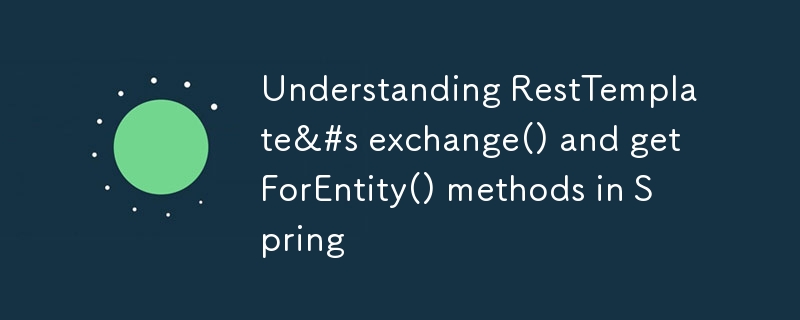了解 Spring 中 RestTemplate 的 Exchange() 和 getForEntity() 方法
- 王林原创
- 2024-08-21 20:12:30710浏览

在 Java Web 开发领域,使用 RESTful 服务是一种常见需求。 Spring框架提供了一个名为RestTemplate的强大工具,它简化了发出HTTP请求的过程。在其各种方法中,exchange() 和 getForEntity() 是最常用的两个。在本文中,我们将探讨这两种方法之间的差异、何时使用每种方法,并提供实际示例来说明它们的用法。
什么是 RestTemplate?
RestTemplate是Spring提供的用于发出HTTP请求的同步客户端。它抽象了 HTTP 通信的复杂性,并允许开发人员与 RESTful 服务无缝交互。使用 RestTemplate,您可以执行 GET、POST、PUT 和 DELETE 请求等各种操作,使其成为 Web 应用程序的多功能选择。
Exchange() 和 getForEntity() 概述
交换()
exchange() 方法是一种更通用的方法,可以处理所有 HTTP 方法(GET、POST、PUT、DELETE 等)。它允许您指定要使用的 HTTP 方法,以及可以包含标头和请求正文的请求实体。这种灵活性使得 Exchange() 适合广泛的场景。
主要特点:
- 支持所有 HTTP 方法。
- 允许自定义请求标头和正文。
- 返回包含响应正文、状态代码和标头的 ResponseEntity。
getForEntity()
相比之下,getForEntity() 是专门为发出 GET 请求而设计的。它简化了从 RESTful 服务检索资源的过程,无需额外配置。这种方法比较简单,非常适合只需要获取数据的场景。
主要特点:
- 专为 GET 请求而设计。
- 简化了发出 GET 请求的过程。
- 返回一个类似于exchange()的ResponseEntity。
何时使用每种方法
使用exchange() 何时:
- 您需要执行 GET 以外的 HTTP 方法(例如 POST、PUT、DELETE)。
- 您想要随请求一起发送额外的标头或请求正文。
- 您需要对 HTTP 请求进行更多控制。
使用 getForEntity() 时:
- 您想要发出一个简单的 GET 请求,无需额外的标头或正文。
- 您更喜欢更简洁、更易读的数据检索方法。
实际例子
使用 Exchange() 的示例
import org.springframework.http.HttpEntity;
import org.springframework.http.HttpHeaders;
import org.springframework.http.HttpMethod;
import org.springframework.http.ResponseEntity;
import org.springframework.web.client.RestTemplate;
public class Example {
public static void main(String[] args) {
RestTemplate restTemplate = new RestTemplate();
HttpHeaders headers = new HttpHeaders();
headers.set("Authorization", "Bearer your_token_here");
HttpEntity<String> entity = new HttpEntity<>(headers);
ResponseEntity<MyResponseType> response = restTemplate.exchange(
"https://api.example.com/resource",
HttpMethod.GET,
entity,
MyResponseType.class
);
System.out.println(response.getBody());
}
}
使用 getForEntity() 的示例
import org.springframework.http.ResponseEntity;
import org.springframework.web.client.RestTemplate;
public class Example {
public static void main(String[] args) {
RestTemplate restTemplate = new RestTemplate();
ResponseEntity<MyResponseType> response = restTemplate.getForEntity(
"https://api.example.com/resource",
MyResponseType.class
);
System.out.println(response.getBody());
}
}
结论 :
总之,RestTemplate 中的 Exchange() 和 getForEntity() 方法都有不同的用途。 Exchange() 为各种 HTTP 方法和自定义选项提供了灵活性,而 getForEntity() 则提供了一种简单而有效的方法来发出 GET 请求。了解这些方法之间的差异将帮助您为您的特定用例选择正确的方法,使您与 RESTful 服务的交互更轻松、更高效。
编码愉快!
谢谢,
Java 宪章!
凯拉什·尼尔玛尔
以上是了解 Spring 中 RestTemplate 的 Exchange() 和 getForEntity() 方法的详细内容。更多信息请关注PHP中文网其他相关文章!

